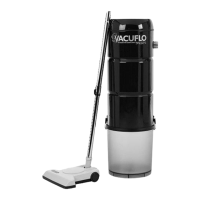
Do you have a question about the Vacuflo 760 Dual Motor and is the answer not in the manual?
| Brand | Vacuflo |
|---|---|
| Model | 760 Dual Motor |
| Category | Central Vacuum Systems |
| Language | English |
Guide on selecting the optimal placement for the central vacuum power unit based on environmental factors and accessibility.
Advice on choosing ideal positions for inlet valves to maximize cleaning coverage and hose reach throughout the house.
Instructions on planning the layout of the vacuum tubing system, emphasizing straight lines and efficient fitting usage.
Detailed steps for cutting, dry fitting, and cementing PVC tubing and fittings to create airtight seals for the vacuum system.
Explanation of how to run and connect the low voltage wire that activates the power unit from the inlet valves.
Guidance on mounting the power unit, including electrical requirements and grounding instructions for safe operation.
Procedures for cutting holes and mounting inlet valves in existing home walls and floors, ensuring proper fit and wire connections.
Methods for installing inlet valves in closets or floors when standard wall installations are not feasible.
Steps for roughing in inlet valves and wiring during the framing stage of new home construction.
Specific installation methods for inlet valves in thin walls or utility valves in exposed areas.
Final steps for connecting branch lines to the trunk line, running low voltage wire, and connecting to the power unit.
